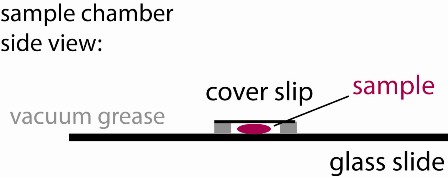Procedure: Diffusion in biological gels
| |
This procedure uses sensitive biological samples. Wear gloves to avoid contamination. |
Summary
You are going to test the diffusion behavior of three different particle types in matrigel. The three particle species are:
a) 1 µm liposomes, positively charged
b) 1 µm liposomes, neutral
c) 500 nm polystyrene beads, positively charged
Each of these analytes are prepared for you in tubes and will be kept on ice any day someone says they are going to do the particle tracking.
Making a sample Chamber
1) Use the vacuum grease filled syringe to place an open ~ 15x15 mm square on the middle of a glass slide. Make sure it is small enough so that it can be fully covered with a small cover slip. Ensure that the linings are continuous (see figure), otherwise your sample chamber will leak and you will have lots of drift.
a) You will need to hold on to the base of the tip on the syringe, as it will tend to unscrew. If it does, simply screw it back in and hold on tigher.
2) Once it is prepared below, place ~30 µl of your sample into the vacuum grease well of the sample chamber you crafted above.
3) Label the glass slide to keep track of your sample. Be precise because your samples may last a few days if you keep them wrapped in foil.
4) Cover the well with a small cover slip creating a sandwich (see figure). Press only enough to make contact with the sample and provide a continuous seal around the perimeter of your well. If some fluid leaks out, that is OK, just gently slide the cover slip around laterally to better ensure a continuous seal. To check, look around the perimeter at a glancing angle, using the bench ligths for illuination.
Part II: preparing the gel/particle mixtures
1) Defrost a 75 µl aliquot of matrigel on ice.
2) Once the gel has thawed, distribute 25 µl each into a total of 3 small test tubes and keep them on ice as well.
3) Dilute two of these 25 µl aliquots 1:1 with DMEM and the third aliquot with the salt solution you have received to a total of 50 µl each; mix by gentle pipetting, avoid creating bubbles! NEVER vortex the protein solution! Keep the aliquots on ice while diluting.
4) Add 1 µl of a particle dilution you created in part I to the diluted gel solutions: use neutral liposomes for the first of the DMEM aliquots and positively charged liposomes for the second DMEM aliquot. Add the polystyrene particles to the aliquot with the salt solution. Mix the particles in by gentle pipetting, avoid creating bubbles! Label your test tubes accordingly to keep track of your sample mixtures! You should now have three aliquots containing 51 µl of a gel/particle mixture each. Keep all the aliquots on ice!
5) Craft and fill three sample chambers as in step 2 and 3 of part I. Fill each sample chamber with a different sample and label the glass slides accordingly.
6) Place all of your filled sample chambers for 20 minutes in the incubator at 37°C to induce gelation.
7) Your hydrogel samples are now ready for microscopy.


